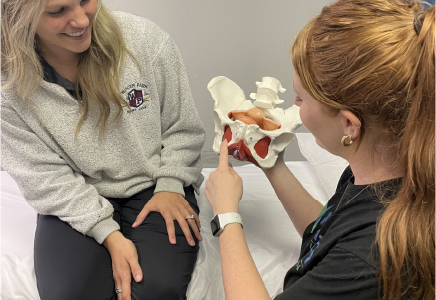Target Area: Pelvic Area
Overview
Conditions
What & How We Treat
Not Sure if Therapy is Right for You?
Have a free discovery call to talk with one of our therapists.

How can Physical Therapy help me?
Physical Therapy is a trusted healthcare industry dedicated to evaluating and treating certain injuries and illnesses. The goal of Physical Therapists is to ease pain by helping you to move, live, and function better. [Source: bls.gov]. Also known as physiotherapists,...
Other Target Areas
Head
Jaw/TMJ
Neck
Ear
Back
Shoulder
Elbow
Hand
Hip
Pelvic Floor
Knee
Foot
Ankle
Balance
Where is My Pelvic Pain Coming From?
Pelvic pain can originate from several sources, including postpartum complications, urinary dysfunction, pelvic organ prolapse, or issues with the pelvic floor muscles themselves. Pelvic floor physical therapy focuses on addressing dysfunction in this network of muscles, ligaments, and connective tissues that support pelvic organs like the bladder, uterus (in females), and rectum. When these structures are compromised, pelvic floor physical therapy can help alleviate significant discomfort and pain by improving muscle strength, coordination, and overall function.
How Pelvic Floor Physical Therapy Can Help
Pelvic floor physical therapy is a specialized treatment approach that can significantly benefit both men and women experiencing pelvic pain. This therapy focuses on strengthening and rehabilitating the pelvic floor muscles to restore proper function and alleviate pain. Whether your pain is related to postpartum recovery, urinary dysfunction, or pelvic organ prolapse, pelvic floor physical therapy can help address the root cause of your symptoms.
Personalized Treatment Plans at Precision Rehabilitation
Precision Rehabilitation’s pelvic floor physical therapists aim to focus more on just the symptoms, our program treats the underlying causes of pelvic pain and dysfunction. By focusing on the specific muscles and tissues involved, this therapy can provide targeted relief and help prevent future issues. At our clinics located in South Louisiana, we are dedicated to offering the highest standard of care to ensure you receive the best possible outcomes.
Pelvic floor physical therapy offers an effective solution for individuals experiencing pelvic pain and dysfunction. Whether you’re facing postpartum challenges, urinary issues, or pelvic organ prolapse, our specialized therapy is designed to provide the relief and support necessary for your recovery.

Common Pelvic Floor Pain Conditions
- Pelvic Pain
- Urinary Incontinence
- Pelvic Organ Prolapse
What & How We Treat
Evaluation and Assessment
We offer physical therapists who specialize in pelvic floor therapy. Treatment begins with a comprehensive evaluation that may include assessing your muscle strength, joint mobility, posture, and the function of the pelvic floor muscles.
Pelvic Floor Muscle Training
We often prescribe pelvic floor exercises (also known as Kegel exercises) which are focused on strengthening weak pelvic floor muscles. In some cases, relaxation exercises may be recommended instead for people with overactive (hypertonic) pelvic floor muscles.
Biofeedback
This technique utilizes electronic monitoring that creates visual or auditory feedback of pelvic floor muscle activity. Biofeedback can be used to help you learn how to control and coordinate your pelvic floor muscles.
Manual Therapy
Our therapists sometimes utilize hands-on techniques to address trigger points, restrictions, and muscle tension in the pelvic floor muscles. The technique may involve external and internal manual therapy to help relieve tightness and increase flexibility.
Bladder and Bowel Training
For people with bladder and bowel control issues, our therapists can implement specific strategies to improve continence – including timed voiding and pelvic floor muscle training.
Postpartum Rehabilitation
Postpartum women are often prescribed pelvic floor physical therapy in order to address issues that may arise after childbirth – including episiotomy healing, perineal tearing, and pelvic floor weakness.




